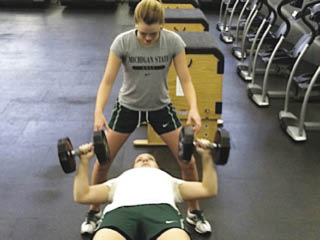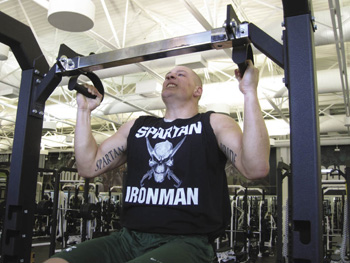Powerline: Strength training for the multisport athlete
 As far as strength training has come in gaining acceptance and being embraced by the athletic community as a vital component to success, some archaic and unfounded notions still prevail.
As far as strength training has come in gaining acceptance and being embraced by the athletic community as a vital component to success, some archaic and unfounded notions still prevail.
A common dilemma at the high school level is the splintering of coaches from different sports when it comes to strength training for the multisport athlete. Unfortunately, we still have coaches who refuse to work in concert with each other on this vital training variable and do so at their athletes’ expense.
After all of these years and the advent of myriad studies supporting and advocating strength training for athletes of all sports — male and female — it is disconcerting that we still have coaches who are either apathetic or adamantly opposed to strength training.”It’s a guys thing” is still echoed by some coaches. Some also claim weights slow you down, cause a loss in flexibility, deteriorate skill level and erode quickness, and a host of other unfounded fairy tales. So much for new millennium thinking!
I feel comfortable addressing this topic, as I spent 10 years at the high school level. Along with a couple of other coaches who were believers, we made the best possible program available to our athletes. We did not have a lot to work with in terms of space or equipment, but with a combination of some functional free weights, benches, racks, machines and a lot of manual resistance, we put a fairly decent program together.
It worked because everyone — the coaches and athletes — believed in what we were doing.
This installment of Powerline serves a two-fold purpose: To offer valuable insights to those who are opposed to, or on the fence, about year-round strength training for multi-sport athletes, and to reaffirm its importance for those who carry the pro-strength training banner with fervor.
Year-round importance
Strength training offers both male and female athletes of all sports an undeniable portfolio of mental and physical benefits. The following list in itself builds a solid foundation in support for keeping it as a mainstay.
- Improved flexibility. Keeping in mind that muscles work in pairs (i.e., agonists and antagonists), it becomes clearer that a regimen of full-range exercises for as many of the major muscle complexes as possible yields a more flexible athlete. For example, when the quadriceps group (anterior thigh muscles) extends the leg, the hamstring group (posterior thigh muscles) is stretched. The opposite is in effect when the hamstring group flexes the thigh.
The unfounded notion that strength training negatively affects flexibility still persists in some coaching circles and it stymies the full physical development of the athletes under their watch. A well-constructed program that accounts for properly performed movements in a comprehensive, biomechanically sound, full-range manner improves both flexibility and strength.
- Improved body composition. Body composition is the relative amount of fat tissue and lean tissue (i.e., bones and muscle) we carry in our bodies. Through various modes of body comp testing, an athletes percent of body fat is determined.
 Males can range anywhere from single digits to the mid-twenties, and females are usually in the teens to low twenties. Comparatively speaking for a variety of gender-related reasons females usually have a higher body fat composition relative to lean weight values than males.
Males can range anywhere from single digits to the mid-twenties, and females are usually in the teens to low twenties. Comparatively speaking for a variety of gender-related reasons females usually have a higher body fat composition relative to lean weight values than males.
When it is determined that the body fat value is too high, the natural inclination is to start dieting and engaging in some sort of endurance/cardio training. Lost in this approach is that neither accounts for muscle tissue the power source for the athletic machine.
A better approach is to combine proper nutritional habits, sport-specific conditioning procedures and year-round strength training to achieve an efficient, fine-tuned physique that is ready for the rigors of the sport in question. Additionally, the body becomes a highly effective calorie burner, as explained below.
- Heightened resting metabolism. Muscle tissue is extremely active and is dependent upon a constant energy source. Thus, it requires a higher metabolic rate. As muscle tissue grows and is maintained, the resulting metabolic burn aids in calorie utilization, even when the body is at rest.
For example, a mere increase of three pounds of muscle can raise your resting metabolic rate by around seven percent. We also know that every new pound of muscle gained results somewhere in the neighborhood of 30 to 50 calories burned per day at rest for tissue maintenance.
The result of a higher resting metabolic rate is an athlete who preserves his or her body composition and athletic efficiency, even in the offseason.
- Power points. Coaches know that power is the product of muscle force and movement speed. As strength improves, there is a subsequent improvement in muscle force production.
As this newly developed ability to generate increased levels of muscle force is applied to highly organized skill learning and development, the result is athletes who perform the skills of their sport or position with enhanced speed and power.
Simply put, if you continue to work on the skill-sets of your sport or position with efficiency and quality, strength training increases the speed and quickness of those requirements.
- An aid in reducing the severity and incidence of injury. Think of muscles as the body’s shock absorbers. The better trained they are, the stronger and more resilient the musculoskeletal system becomes when faced with the onslaught of practices, games, collisions and the normal wear and tear of the competitive season.
Also, progressive resistance exercise enables bones to lay down mineral content and increases their protein, thus improving bone mineral density and making for a stouter skeletal system.
The above highlighted points stand on their own and make a strong case for year-round strength training. Now that we have set the stage for strength training with all athletes in all sports let’s look at some suggestions for making it a viable option for the multi-sport athlete.
Setting policy/devising a game plan
There are several approaches and troubleshooting strategies for architecting a training solution for your multisport athletes. In my opinion, the following three suggestions offer at least a start in opening the lines of communication among administrators and coaches.
1. Administrators and coaches should consider setting policies when it comes to the schools athletic strength training procedures. For far too many years, strength training within the schools athletic department has been an every man for himself hodgepodge of philosophies, techniques, equipment preferences and a host of other friction-serving issues.
To help combat this dilemma, athletic directors should include noted experts in strength and conditioning in their mandatory in-service sessions to offer advice in developing and maintaining a department-wide strength training program.
Once the material is presented, the administrators and coaches should dissect what they’ve learned and make determinations based upon safety, applicability to their athletes needs and experience, instructional considerations, equipment compatibility and its appeal to all coaches within the program.
This is by no means a one and done endeavor, as you want to absorb a variety of ideas and approaches from different sources. There is no harm in specific coaches adding or deleting from the menu as time goes on, as many of them are learning what they need and like on the run.
What is important, however, is that those lines of communication to others in the athletic department remain intact. This is especially true, as it makes for a much easier transition when an athlete crosses over into another sport.
2. Consider implementing a strength and conditioning class as part of the health and physical education curriculum. We have mentioned this before as an option for the in-season athlete and it’s an even more viable answer for the multisport athlete.
A qualified instructor adjusts the intensity, frequency, volume and progression of the training to fit the athletes competitive schedule. This allows for strength gains without delving into the required energy reserves for both practices and games.
So much of proper strength training during the in-season period is dependent upon timing much like proper nutrition, and this component can be successfully addressed with close supervision and precise documentation.
Obviously, the frequency of training for multi-event sports (i.e., those with more than one competition per week) demands stringent organization, but still can be administered with excellent results.
A more undulating type of system, i.e., one that is flexible regarding the scheduling, format (e.g., upper-body, lower-body or total-body workouts) and volume (total work sets) of training days can be devised by the instructor.
3. Coaching agreement on training procedures when the athlete transitions into another sport. This is an easy option when the head coaches of two different sports are eye-to-eye on the significance of strength training. It becomes a little more heated, however, when the lines of communication are frayed or completely disconnected.
This is where education on the previously mentioned benefits of strength training must be the overriding and determining factor. How it gets done is up to the interjection of common sense between the coaches.
For instance, if a basketball coach is not an avid student of strength training and does not mandate that players strength train, he or she should permit the multisport athletes on the team to perform a modified version of their other sports offseason program. This may involve a complete restructuring of the program (as stated in the class option), but common ground can, and should, be attained.
The football coach, for example, can administer an altered version of their program with good intentions and the blessing of the basketball coach, and certainly with the understanding that they must keep the players fresh for their basketball duties.
Again, we are talking about procedures that are in the athletes best interests; ones that are proven, crucial and beyond revocation.
Final rep
A strong musculoskeletal system provides athletes with an efficiently running engine that improves physical performance and reduces the likelihood or severity of injuries. It improves self-esteem and confidence, and enhances overall health and appearance. It’s as integral a part of the total training package as any other developmental variable.
As coaches, we need to provide all of our athletes with these advantages during their competitive years and as solid lifestyle habits for their adult lives.
Strength training improves flexibility, body composition and increases resting metabolism, which benefits all athletes. Implement a strength and conditioning class in your school’s curriculum as soon as you can.
Ken Mannie is the head strength and conditioning coach Michigan State University. His column, Powerline, appears regularly in Coach & Athletic Director magazine.


